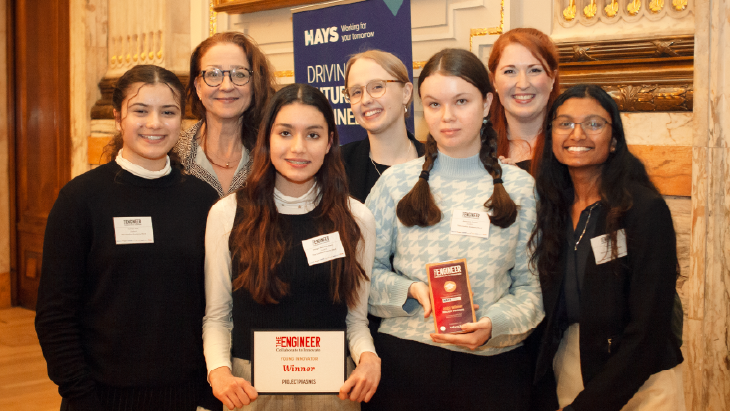Collaborate to Innovate Awards: designing sustainable homes for the future
5 min read | Paul Gibbens | Article | Workplace | Diversity, Equity & Inclusion

Five forward-thinking schoolchildren have designed a sustainable home, featuring a pollinator-friendly green roof, natural air conditioning, and even a carbon-capture system that can power cars.
‘Project Prasinos’ is made up of five year 11 students from The Ursuline Academy Ilford: Anastasia Pausey, Sumaya Riaz, Imogen Bess Van-Beers, Prithika Premkumar, and Rianne Beno. The project was formally recognised by The Engineer magazine at the Collaborate to Innovate Awards, which celebrates the very best in engineering innovations, from cancer-detecting medical devices to low-carbon aircraft technology. The students from The Ursuline Academy received the Young Innovator Award, which spotlights young engineers tackling some of society’s biggest challenges – a category of particular interest to me as a STEM ambassador.
Sustainability in the spotlight
Every detail of the pupils’ design has been carefully considered, especially when it comes to sustainability. “We all share a passion and enthusiasm for sustainability in the built environment,” one student said, “sustainability is at the core of our project – we view it as a lifeline for survival.”
The home’s electricity is generated by transparent glass solar panels, provided by the project partner, Polysolar. The panels also provide thermal insulation equivalent to that of triple-glazed windows and the residents’ cars can be powered by the hydrogen produced as a by-product of the building’s carbon capture system.
“Global emissions can have a huge impact on our quality of life, the rate of disease in society, and overall life expectancy, so it was essential that we incorporated sustainable elements into our building design.”
Other notable elements of the design include the lightweight, flexible, and weather-resistant bricks, provided by the manufacturing company, Saint-Gobain, the pollinator-friendly green roof, and the white barium sulphate paint on the exterior, which reflects nearly 92% of sunlight.
“We realised that there’s no single solution to a problem as massive and complex as climate change. However, incorporating pre-engineered solutions in a new and innovative way could have a significant impact on the carbon footprint of our future homes.”
Adapting and refining the design
The schoolchildren started working on the project during the pandemic over two years ago and have dedicated multiple inset days, lunchtimes, and half-term holidays to it. They’ve learned how to use computer-aided software (CAD) to produce detailed 2D and 3D models, as well as how to adjust their plans according to feedback from market research. It was important to the students that the finished product is a home that’s sustainable, attractive, and accessible for everyone, including the elderly and people with disabilities.
Changing perceptions of the engineering industry
The project has broadened the pupils’ perspective on what a career in engineering could look like and helped bust some of the common myths surrounding the profession. They’ve benefited from real-world experience in an engineering environment, through their placements with Polysolar and Saint-Gobain.
“We’ve come to realise the importance of creativity and collaboration when devising engineering solutions, and having a diverse team of different genders, ages, and backgrounds can help facilitate this.”
Most of the students want to pursue a career in engineering, with some considering mechanical engineering, aerospace engineering, and biomedical engineering, and the project has helped them gain a better understanding of the profession beyond the school curriculum. “Regardless of what careers we want to pursue,” one student explained, “we’ve all gained transferable skills, including problem-solving, time management, and creativity, that will be applicable to all our exams and future careers, no matter the subject or industry.”
“Our teachers encouraged us to be proud of ourselves no matter the outcome, but we’re absolutely over the moon to have won the Young Innovator Award. Overall, it’s been an invaluable experience for us.”
Here at Hays, we support the next generation of engineers. To find out more about the industry and why you should consider a career in engineering, get in touch with one of our specialist consultants or search our latest engineering jobs today.
About this author
Paul Gibbens, National Specialism Director, Engineering, Hays
Paul began his recruitment career in 2005 before joining Hays in November 2019. Paul is an experienced customer-focused director with extensive knowledge of the nuclear, MOD & defence, oil & gas, rail, power generation, petrochemical, chemical, renewable energy, and manufacturing industries.
